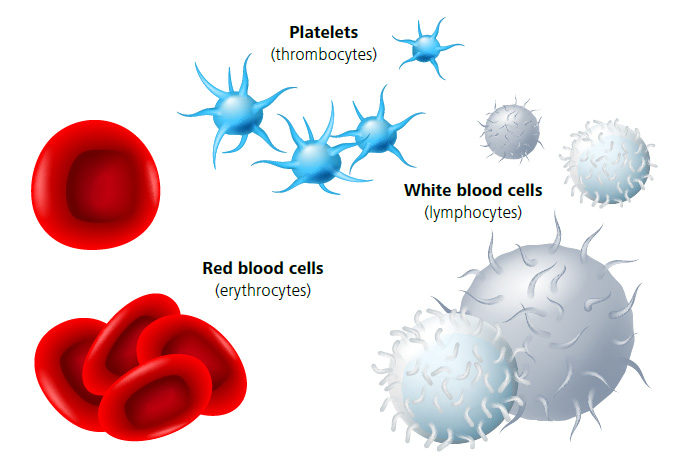Hematology Explained
Sep 27th 2022
 Hematology is the study of blood and blood disorders. Hematologists analyze blood smears under a microscope to look for abnormalities that indicate blood disorders. What kinds of cells do they see under the microscope, and what kinds of abnormalities might be present?
Hematology is the study of blood and blood disorders. Hematologists analyze blood smears under a microscope to look for abnormalities that indicate blood disorders. What kinds of cells do they see under the microscope, and what kinds of abnormalities might be present?
Blood Cell Types
Blood is made up of blood cells and blood plasma. About half of blood is made of blood plasma, which contains nutrients, blood clotting factors, hormones, and waste products. The other half of blood is made of blood cells, which fall into three categories: red blood cells (erythrocytes), white blood cells (leukocytes), and platelets (thrombocytes).
- Red Blood Cells
These cells transport oxygen from the lungs around the body, and carry carbon dioxide from organs and tissues in the body back to the lungs. Their name comes from their red color, which is due to hemoglobin, the protein that binds oxygen to blood cells. They are about 7.5 µm in diameter.
- Platelets
These cells are critical for blood clotting and stopping the flow of blood after an injury (called hemostasis). When an injury occurs, platelets stick to the damaged area and form a clot. Then, coagulation factors help to stabilize the clot. Finally, the existing clot is transformed into a clot made of a substance called fibrin, which eventually will heal into the type of tissue that was present prior to injury. Platelets are 2-3 µm in diameter.
- White Blood Cells
These cells are critical for the body’s immune system. White blood cells are further broken down into three cells types: granulocytes, monocytes, and lymphocytes. Granulocytes, which include basophils, eosinophils, and neutrophils, circulate in the blood stream and help patrol for problems. They can defend the body against parasites and are involved in allergic reactions. Monocytes also help with these functions and can transform into macrophages, which can ingest and degrade bacteria inside the body. Macrophages also help to clear cellular debris and recycle dead cells. Lymphocytes are responsible for creating antibodies, and are therefore key to the body’s immune response to an infection. Diameters of the various white blood cell types range from 7 to 20 µm.
Analyzing Blood Under the Microscope
Hematologists use various laboratory tests analyze the blood to look for abnormalities. Two examples of commonly used blood tests are described below.
- A Complete Blood Count (CBC) Test counts cells that make up your blood (red blood cells, white blood cells, and platelets). This test can point to various medical conditions if the concentrations of the different cell types are not at the appropriate levels. For example, a low red blood cell count may indicate anemia. An elevated white blood cell count can indicate inflammation or infection, and a too low white blood cell count may indicate a viral infection or a bone marrow disease.
- A Blood Differential Test measures the percentage of different white blood cell types that are present in blood. Too high or too low of a percentage of different types of white blood cells may indicate the presence of disease. For example, a decreased percentage of lymphocytes may indicate an HIV/ AIDS infection, leukemia, or radiation therapy or exposure. An increased percentage of monocytes may indicate a chronic inflammatory disease or a parasitic infection.
Hematology Microscopes Available from Microscope World
Using the right microscope is critical in order for hematologists to perform their analyses. Microscope World has a number of microscopes especially suited for the analysis of hematology samples.
Have questions about which microscope is right for you? Contact Microscope World at 800-942-0528.
Related Articles of Interest:
Choosing a Hematology Microscope






